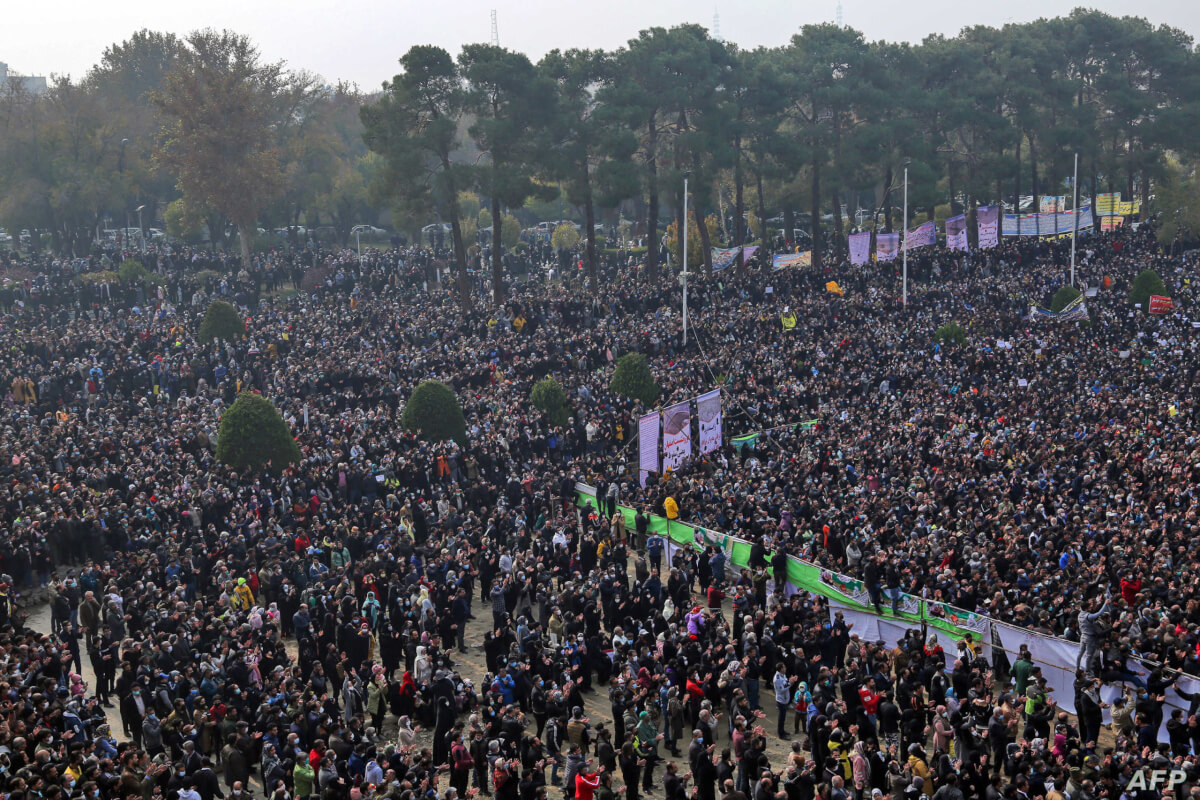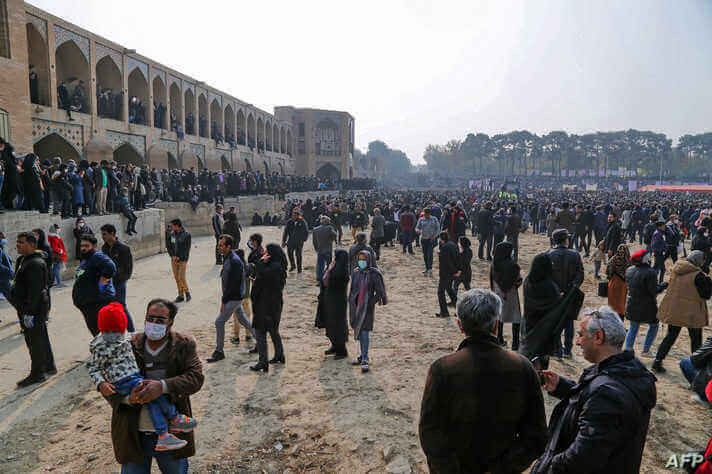
It seems that the Iranian cycle of repression continues, amid the violence practiced by the security forces against the demonstrations of the people of Isfahan who are protesting against the regime’s policies in Tehran, which caused the drying up of a river that is the main source of water in the city, according to Iranian sources.
Despite the calm that prevailed in Isfahan on Saturday, dozens of the city’s residents were arrested, whom the authorities considered a group of “rioters” while demanding water, which is the lifeline.
For more than two weeks, the residents of Isfahan have been organizing demonstrations to protest the drying up of the Zayandhrod River because of the regime’s policies, they say, and the security forces responded violently to these demonstrations.
Systematic Repression
Director of the Ahwazi Center for Media and Strategic Studies, Hassan Radi, told The Eastern Herald that “what is happening in Isfahan are popular protests by farmers and citizens in Isfahan against the policies of the Iranian regime.”

He added that the demonstrators were demanding “the opening of the dams on the Zayandhrod River, which crosses Isfahan, on which farmers depend mainly.”
Radi pointed out that while the policies of the regime in Tehran are draining the river that people depend on, they are providing water to iron and steel factories, and selling it to neighboring countries.
He stressed that the reason for the drying up of the waters in this river is not entirely due to natural causes, but rather that the regime and its policies played a major role in what happened.
#BREAKING Iranian protesters continue to fill the streets in the city of Isfahan chanting anti-regime slogans including "Bless You Reza Shah" which is considered the most strategic chant, targeting the heart of the clerical dictatorship. #IranProtests pic.twitter.com/wkMzUAQPSb
— Shayan X (@ShayanX0) November 26, 2021
The regime in Iran deals with the demonstrations through “systematic repression”, which amounts to live fire on protesters, not to mention the arrests targeting demonstrators and their families, according to Radi.
Radi feared that the international community would not intervene to support the residents of Isfahan, pointing out that Western countries do not want to aggravate relations with Tehran, especially ahead of the talks that will take place in the coming days.
It is expected that if negotiations with Iran fail, the international community will change its policy and press towards supporting the protests in Isfahan and the whole country.
Dozens arrested
On Saturday, Iranian police announced the arrest of nearly 70 people following violent protests against the backdrop of the drying up of the famous river in Isfahan, the third-largest city in Iran.
For more than two weeks, the residents of Isfahan have been organizing demonstrations to protest against the severe drought that the region has been experiencing for years.
On Friday, security forces fired tear gas at protesters who threw stones, while about hundreds of people gathered near the Zayandhrod River, which runs through Isfahan.
The city of Isfahan was calm on Saturday, according to witnesses who spoke to AFP, while riot police were deployed.
The Seidehrod River, dry since 2000, which runs through the country’s third-largest city, has become the main gathering place for protesters.
https://twitter.com/AlinejadMasih/status/1461691451025330181
In addition to the drought due to climate warming, residents accuse the authorities of diverting water from the city to supply neighboring Yazd province, which also suffers from severe water shortages.
“I am used to walking down the river with friends, but riot police are deployed in large numbers near Khaju Bridge and are asking residents to avoid this area,” a woman in her fifties told AFP by phone.
On Saturday, a resident of the area told state television that “the situation was calm in the course of the Zayindrod river and the streets were empty, but I heard about the deployment of riot police on the Khaju Bridge”, which runs across this river.
Official version
“Among the wounded protesters, two are in a critical condition,” Mehr news agency quoted Isfahan University Hospital spokesman Noureddin Soltian as saying on Saturday. He did not indicate any deaths.

Hassan Karami, a commander in the Iranian police said that 67 people were arrested among the demonstrators, according to a report published by Radio Farda .
He pointed out that nearly 3,000 rioters participated in Friday’s demonstrations in Isfahan, which is located 400 km south of the Iranian capital, Tehran.
The arrests were carried out by the police, the Revolutionary Guards, and the intelligence services.
According to Karami, “30,000 to 40,000 farmers and residents of Isfahan participated in the demonstrations last week.”
“After the farmers left, the opportunists remained, which allowed the security services to easily identify and arrest the people who destroyed public property,” Isfahan police chief Mohammad Reza Mirhaidari told television Friday.
People chanting "Death to the Dictator" in Isfahan Zayandeh Rud riverbed as they confront the repressive forces on Friday morning, 26 Nov 2021, in a per-announced protest against the regime #IranProtests pic.twitter.com/mopFiOXYm2
— Alireza Jafarzadeh (@A_Jafarzadeh) November 26, 2021
“As a result of throwing stones and using explosives and sound bombs, some of our colleagues were injured, while others were wounded by hunting rifles,” he explained.
“A policeman was also stabbed, but his condition is stable,” he added.
Ayatollah Ali Khamenei, Iran’s supreme leader, said in statements that “the water crisis is a top priority for the government.”
On Thursday, an agreement was reached between farmers in the Isfahan region and the authorities to distribute 50 million cubic meters of water, according to Fars news agency.
According to the same agency, a water pipe carrying water from Isfahan province to Yazd was destroyed last Thursday night with a bulldozer, and three water tanks were destroyed. As a result, drinking water has been cut off in some areas of Yazd Province.
Iranian media
The press was divided Saturday over the events. The hard-line conservative Kayhan newspaper accused “mercenary thugs of starting riots and spreading an atmosphere of terror among passersby.”
Unrest in #Iran –
Mullahs vs. The People in #Isfahan. pic.twitter.com/ZCTapzURS0— Tarek Fatah (@TarekFatah) November 27, 2021
On the other hand, the reformist Etemad newspaper wrote that “the reason for the new wave of protests is the protesters’ lack of confidence in the government to solve problems.”
American concern
For its part, the United States expressed its “deep concern” about the Iranian security crackdown in Isfahan, the State Department said Saturday.
State Department spokesman Ned Price said on Twitter: “I am deeply concerned about the violent security crackdown on peaceful protesters…the Iranian people have the right to express their frustration and hold their government accountable.”
Iran has been suffering from a chronic drought for years, which has led to frequent floods caused by a combination of soil erosion and moderately heavy rains.











